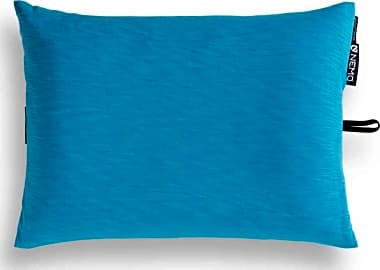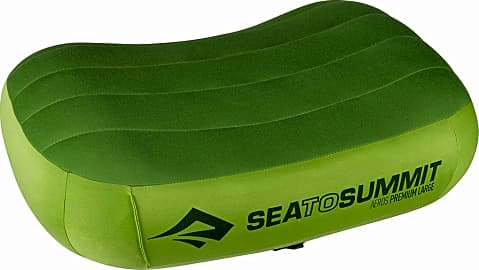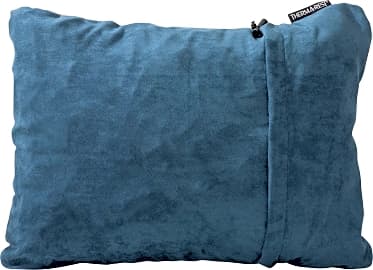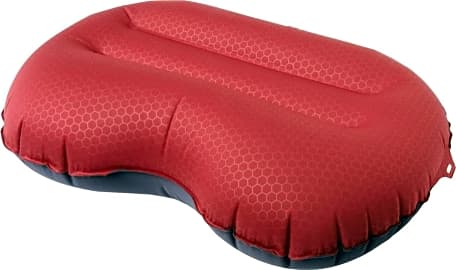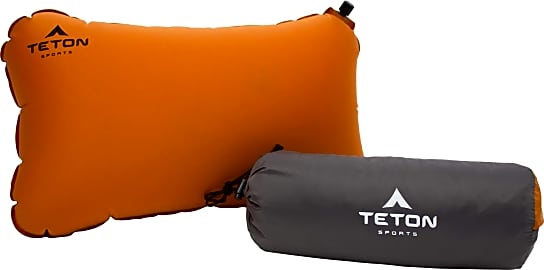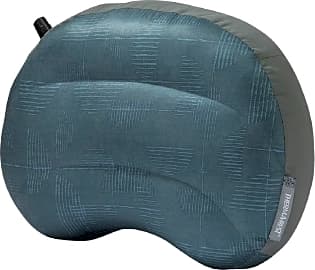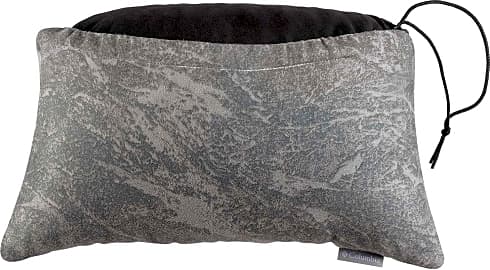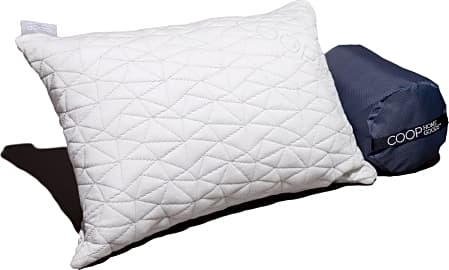The 10 Best Camping Pillows

This wiki has been updated 37 times since it was first published in September of 2015. There is no need to rest your head on an uncomfortable backpack (or a log) on your next outdoor adventure, thanks to these camping pillows, which are specially designed to be lightweight and compress down compactly, so you can stow them away easily and save space for more important gear. Many are also extremely comfortable, allowing you to get a good night's sleep just about anywhere. When users buy our independently chosen editorial recommendations, we may earn commissions to help fund the Wiki.
Editor's Notes
August 18, 2020:
When you're camping, almost nothing is as bad as a poor night's sleep, but any one of these options will make sure you get your Zs. We maintained a range of ultralight models for backpackers, as well as more substantial choices for car campers, with plenty of choices in between. As for the lightest options, look to the Trekology Aluft 2.0 or the Nemo Fillo Elite, which replaces the Nemo Fillo. The Elite weighs very little, boasts recycled materials, and packs down exceptionally small, so there's virtually no reason to leave it behind. The Teton Sports ComfortLite remains a good choice, as well, although it's a touch heavier at 12 ounces. On the plus side, it self-inflates, a definite bonus when you're tired.
Those who aren't as concerned about weight might look at the Therm-a-Rest Compressible or the Coop Home Goods Premium. These models are not inflatable, so they'll never leave you with that "sleeping on a balloon" feeling. In fact, either is comfortable enough to work as an all-purpose travel pillow; the Therm-a-Rest even comes in a huge range of colors and patterns, so you could match it to your camping pad or luggage. If you'd prefer a hybrid inflatable/cushioned option, consider instead the Klymit Luxe or the Therm-a-Rest Air Head.
May 30, 2019:
Sure, you could drag your old down pillow along with you on your next trek, but you'll likely have to sacrifice much-needed space for it. That's what these camping headrests were designed for -- to keep you sleeping like a baby on all your adventures while also saving you space and weight for other gear. We combed through over two dozen models in putting this list together, making sure to select the best of the best across a wide range of applications. That includes options that prioritize comfort over packability, such as the Coop Home Goods Premium or the Therm-a-Rest Compressible, both of which are great choices for more casual campers or even frequent travelers. It also includes models that prioritize the opposite, such as the Sea to Summit Aeros and the Teton Sports ComfortLite, both of which are ideal for ultralight backpackers and minimalist trekkers trying to cut down on their pack weight. Ultimately, we judged the Klymit Luxe to be best for most people, since it offers a smart balance between size and shape for users of all types.
Special Honors
Western Mountaineering Cloudrest You don't have to leave behind the comfort of plush down just because you're in the great outdoors. The Western Mountaineering Cloudrest features 3.5 ounces of goose down, but weighs only 5 ounces in total; this light weight, combined with the integrated stuff sack, ensures it can easily travel along with you. westernmountaineering.com
Hyperlite Mountain Gear Stuff Sack Pillow Instead of carrying along a separate pillow, you can keep your pack weight down with the Hyperlite Mountain Gear Stuff Sack Pillow, which acts as a stuff sack by day and resting place for your head by night. You can make it harder or softer, depending on how much clothing you stash in it, and count on the soft fleece lining to help you sleep soundly. hyperlitemountaingear.com
Tom Bihn Pocket Travel Pillow The Tom Bihn Pocket Travel Pillow barely tips the scales at a mere 12 grams, but you'll need to provide a jacket or sweater to fill it, as it is, essentially, an empty case that can transform into a cushion. A diminutive choice, it has a handy loop for attaching it to a strap or keychain for safekeeping while you're on the go. tombihn.com
The Popularity Of Camping In America
Initially, the concept didn't take hold with mainstream consumers, but at the turn of the 20th century, interest began to pick up.
The idea of camping as an enjoyable pastime first took hold in America in the late 1800s. The first two established campsites in the United States were Gunnery Camp, founded in 1861, and Sea Rest, a YMCA camp founded in 1874. Initially, the concept didn't take hold with mainstream consumers, but at the turn of the 20th century, interest began to pick up. Between 1900 and 1912, the Boys and Girls Club of America, the Boy Scouts, and the Girl Scouts all established camping areas of their own. In the 1930s, the National Park Service developed 34 campgrounds around the U.S., which they called recreation demonstration areas. Fast forward to today, and there are over 100,000 federally managed campsites, more than 150,000 state managed campsites, and countless private facilities.
Studies show that camping is more popular today than ever before. In 2013, over 40 million Americans went camping for a combined total of nearly 600 million days. In 2016, roughly 75 million households contained active campers. This includes those that participate in tent, RV, cabin, and any other form of outdoor camping. That is over 60 percent of American households. Of campers included in the studies, ninety-nine percent said they plan on doing it again in coming years.
One thing worth noting, however, is that the majority of active campers in the United States, 85 percent took their first camping trip before the age of 15. Over 50 percent were also involved in regular outdoor activities as a child. It appears that the possibility of exposing oneself to camping after the age of 15 are slim. These figures underscore the importance of instilling an interest in camping and outdoor activities at a young age.
It also seems that people tend to camp less and less as they age. The average camper is 32 years of age, but more than 90 percent of all campers are under the age of 45. Millennials currently account for nearly 40 percent of U.S. campers, and the number is rising. When asked, most millenials say they enjoy camping as a way to be physically active, spend more social time with family and friends, and just generally attain a better work-life or school-life balance.
The Many Health Benefits Of Camping
Well-known American essayist and poet Ralph Waldo Emerson once wrote that "In the presence of nature, a wild delight runs through man, in spite of real sorrows." He may have written those words over 150 years ago, but they are just as true today as then. There is something about being out in the wilderness that just speaks to the primal instincts modern day humans tend to quash deep within ourselves.
Smartphones have brought technology into our pocket and we spend more time than ever before staring at a screen of some sort.
There are many reasons why spending time camping is good for the body, mind, and soul. It is a rare thing indeed when we can completely unplug in today's society. Smartphones have brought technology into our pocket and we spend more time than ever before staring at a screen of some sort. While this may (or may not, depending on who you ask) be good for productivity, it certainly isn't doing our mental and physical well-being any favors. Studies have shown that excessive screen use can lead to an increase in feelings of anxiety and depression. It can also lead to neck and back pain, depending on the orientation of the screen in comparison to your face. Camping offers the opportunity to completely disconnect from the digital world and reconnect with nature and friends or family.
It must be noted that the high use of social media is actually leading to less and less healthy physical interaction. Camping lets us forget about social media for a little while and just interact with each other. One of the most popular nighttime activities when camping is sitting around the campfire talking. It is the ideal time to reconnect with our loved ones.
Camping has also been shown to promote better sleep. This is because it helps our body get more in line with a natural circadian rhythm. All of the artificial light we use throughout the day, largely at night when our body is supposed to be preparing itself for rest, can negatively affect our ability to attain restful sleep. The blue light emitted from computers, smartphones, and television screens is especially detrimental to the body's ability to produce melatonin. Camping allows the body to reset its circadian rhythm; without the interference of artificial light, we are more prone to abide by the sun's schedule.
People tend to be more active when camping, as well. Instead of spending spare time staring at a screen, campers often hike, fish, swim, and play sports or games during the day. Doing these activities burns calories and also exposes the body to sunlight, which provides vitamin D. Low vitamin D levels have been linked to obesity, depression, and even the development of autoimmune diseases.
Staying Comfortable When Camping — What To Look For In A Camping Pillow
In addition to a sleeping bag or camping pad, a camping pillow is one of the most vital aspects to getting a restful night's sleep while enjoying the great outdoors. There there are many different camping pillows on the market, but they all tend to fall into three main categories: compressible, inflatable, and hybrid.
Compressible pillows are generally filled with down feathers, synthetic fibers, or some kind of foam, sometimes a combination of these materials.
Compressible pillows are generally filled with down feathers, synthetic fibers, or some kind of foam, sometimes a combination of these materials. They are rather plush and tend to be more comfortable than inflatable pillows, but the trade-off is that they weigh more and require more room in your pack. This means they are better for car campers — people who drive to their campsite rather than hike for miles and miles. Down tends to be the softest and most lightweight, but it doesn't retain its shape and plushness as long as foam if compressed constantly. Foam pillows will be slightly heavier, but often cost less then down models and are more durable in the long run.
Inflatable pillows are lightweight and firm, and can be completely rolled up when not in use. They usually have little or no padding. The flip side is that they require a fraction of the space of a compressible pillow. They also deal with water better and can usually dry in less than an hour. Some models can just be wiped off and don't retain any water. Inflatable pillows tend to be the least comfortable. They also produce the most noise as a sleeper moves. For a backpacker who hikes miles between campsites and needs to carry everything on their back, though, an inflatable pillow is usually a smart choice.
Hybrid pillows bridge the gap between the two previously mentioned styles. They will often be inflatable, but have some form of additional padding, most often a compressible foam, on the side where a camper rests their head. This allows them to provide a good amount of support and comfort, while requiring minimal storage space and being light in weight. Most campers will find hybrid models to be comfortable. The best type of pillow, however, will center on the kind of camper you are and your personal sleeping preferences.


